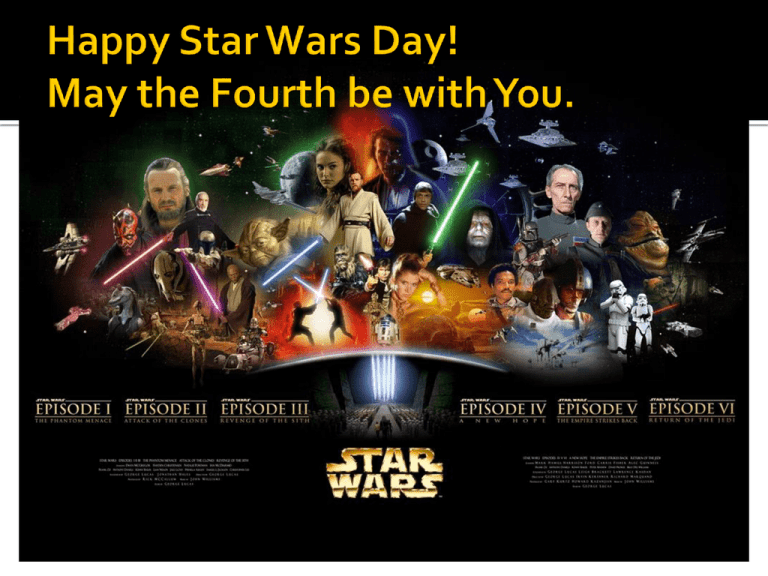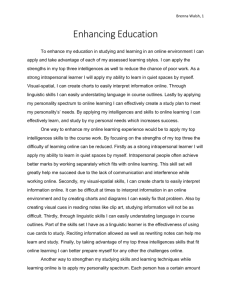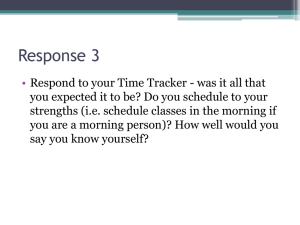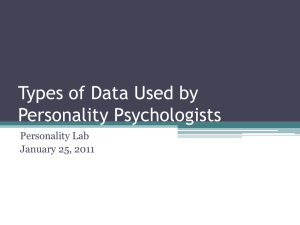11 Success - week 3
advertisement

Chapter 3: Learning How You Learn 2:30-3:30: Computer lab to work on group projects Activity: Team Building/Goal Setting/Multiple Intelligence and Personality Spectrum Discovery Obstacles constantly present themselves. Some are fleeting, such as facing an important test in school. Some may take years to overcome, such as a major injury or the loss of a loved one. Write about an obstacle you’ve faced in your life. Did the experience change you for the better, or did it leave you bitter and cynical? Please claim anything from the box (if you haven’t already) Turn in any homework Find a partner and do your Planner Check for the week Making the most of your abilities figure out their strengths and their weaknesses, and then find ways to capitalize on their strengths – make the most of what they do well – and to correct for or remedy their weaknesses – find ways around what they don’t do well, or make themselves good enough to get by.” Robert Sternberg Your unique intelligence can change and develop Assessments can help you learn about yourself Self-knowledge is an important, lifelong goal How can I maximize what I do well? Assess Your Multiple Intelligences with Pathways to Learning Assess Your Style of Interaction with the Personality Spectrum Multiple Intelligences Learning Preferences What abilities and areas of learning come most easily to you Personality Spectrum Personality Traits How you interact with information and people Sternberg’s Successful Intelligence Focuses on how people process and apply information to learn Concentrates on processes – thinking analytically, creatively, and practically about a situation Gardner’s Multiple Intelligences Focuses on how people intake information to learn Concentrates on domains verbal, logical, bodily, visual, interpersonal, intrapersonal, musical, or naturalist Multiple Intelligences Verbal-Linguistic: Listening, reading, writing, speaking Logical-Mathematical: Math, science, patterns, sequences Bodily-Kinesthetic: Coordination, working with hands Visual-Spatial: Visual art, graphics, charts, maps Interpersonal: Social activity, cooperative learning, teamwork Intrapersonal: Self-awareness, independence Musical: Music, sound sensitivity, patterns Naturalistic: Interest in nature, ecosystem Directions: Rate each statement. Write the number of your response (1–4) on the line next to the statement and total the scores for each set of six questions. 1 = rarely; 2 = sometimes; 3 = usually; 4 = always 1. ___ I enjoy physical activities. 2. ___ I am uncomfortable sitting still. 3. ___ I prefer to learn through doing. 4. ___ When sitting I move my legs or my hands. 5. ___ I enjoy working with my hands. 6. ___ I like to pace when I’m thinking or studying. ____ TOTAL for Bodily-Kinesthetic Complete the questions for each of the multiple intelligences in your book and total up the scores to see where your strengths are. 20–24 Highly Developed 14–19 Moderately Developed Bodily-Kinesthetic 13 Visual-Spatial Verbal-Linguistic 14 20 LogicalMathematical Musical 16 24 Interpersonal 15 Intrapersonal 16 Naturalistic Below 14 Underdeveloped 11 Personality Spectrum Thinker: Giver: Organizer: Adventurer: Analytical, problem solver Authentic, communicator Responsible, detailed Daring, spontaneous Directions: Rank order all four responses to each question from most like you (4) to least like you (1) so that you use the numbers 1, 2, 3, and 4 one time each. Write numbers in the boxes next to the responses. I learn best when the material is a. well organized. b. something I can do hands-on. c. about understanding and improving the human condition. d. intellectually challenging. Complete the exercise and map out your strengths on the brain on the next page. Plot Personality Spectrum scores on this diagram. Classroom Benefits Play to your strengths Work to strengthen weaker areas Ask your instructor for help Study Benefits Helps you pick the right strategies Helps you understand others you are studying with Workplace Benefits Better performance and teamwork Better career planning • Lecture, verbal focus • Lecture with group discussion • Small groups • Visual groups • Logical presentation • Random presentation • Conceptual presentation • Detailed presentation • Experience-based presentation Identifying a Learning Disability Managing a Learning Disability Analytical Thinking – analyze your levels of ability with the Pathways to Learning self-assessment and examine how you relate to people and the world around you with the Personality Spectrum assessment. Creative Thinking – brainstorm how to relate to instructors who teach differently than you learn. Practical Thinking – utilize practical study strategies relating to your own Personality Spectrum and Multiple Intelligence dimensions. “…no two selves, no two consciousnesses, no two minds are exactly alike. Each of us is therefore situated to make a unique contribution to the world.” Howard Gardner, Psychologist and Educator Write on this card: Your name Your Multiple Intelligence (MI) and Personality Spectrum (PS) strengths (i.e. the MI and PS you scored highest in, NOT The number. If you tied, write down the group you joined in the last activity) What ONE THING do you want to have on you/with you at the end of the world. Break into groups: as large or small as you’d like. A virus breaks out of a super-clean research center and infects the population After death, corpses reanimate within 36hrs. Martial law declared: No nongovernment/military are allowed gasoline or vehicles. Orders are to shoot law-breakers on sight. “zombies” can be killed by destroying the brains. Virus spread through oral contact (by zombie or infected) There is a “safe zone” at the Ferry building in San Francisco. 90% sure due to radio announcements. If you walked straight through, it would take you 29hrs to get there. There MAY be teams working through communities to locate and retrieve “survivors” but you’re not 100% sure You may use the items you chose, and anything you can physically carry (you are on foot) Deliverable: Turn in a final list of supplies & team members that arrived safely in SF, as well as a short account of your journey there (1 list per group) . Each PERSON is issued a packet of emergency supplies One canteen Water purification tablets Duct tape Matches Pocket knife Small first aid kit Flashlight Can opener 5 MRE’s (meals ready to eat) Roll of toilet paper Battery operated radio for emergency broadcasts Use CURRENT TIME/CURRENT DAY as start Track what you do, and how far you get @ checkpoints Extra item! Each of you can bring 1 (one) extra item based on your communication preference: Thinkers – 1 tool that you’ve used before Organizers – 1 map (to SF OR of your choice) Givers – 1 medical supply you’ve used before Adventurers – 1 piece of sporting equipment that you’ve used before 1 2 3 4 5 End Game All cell phone towers and major services go down. You have no access to cell phones. No power No water No sewer No gas No police/fire/rescue quad, etc Nothing ever goes as planned If you are OUTSIDE: 2 party members are killed, 1 party member is infected (bitten) If you are INSIDE a building- 2 party members are bitten. One will die within the day (will raise from the dead w/in 36hrs). One may live for quite some time. Nothing ever goes as planned Nothing ever goes as planned Another gang on their way to SF attacks you! If you are OUTSIDE: Loose 3 supplies OR 1 person (killed, not captured). If you are INSIDE: 3 people with no supplies join your group. 1 is injured (not infected) A helicopter passes overhead. If you are OUTSIDE, NOT UNDER A SHELTER: The spotter identifies your group. They can only take 3 passengers. OUTSIDE UNDER A SHELTER: Helicopter doesn’t see you. Nothing ever goes as planned INSIDE: Only sees you if you had somehow marked the roof/put out a signal for rescue Nothing ever goes as planned A light rain begins, which may become a thunderstorm/full on winter storm. If you are INSIDE: Part of the roof collapses If you are OUTSIDE: it rains on you/your group unless you find shelter, slowing travel and increasing chances of illness. Nothing ever goes as planned Night has fallen. If you are OUTSIDE: your group can press on if you have NO CHILDREN with you. If you have children you must find a place to stop for the night. If you are INSIDE, your building becomes surrounded by Zombies. If there are glass doors/ windows that you have not blocked, they are broken and 1 party member dies/becomes infected for each opening you left uncovered. Game over: you’ve arrived at San Francisco (wherever you were, you were finally rescued) or at least survived the first wave. Report in: Where are you? Who is with you? What supplies do you have left? What happened to you on your trip? Turn in one sheet per group with the above in formation, titled Survival, and with all group member names. Get into your Personality Spectrum groups Personality Spectrum – what role did your members take? Leader? Care-giver? Problemsolver? Why do you think that is? Did one person dominate your group? What Personality Spectrum did that person come from? Did you display your group’s qualities (pg 78) Turn in one sheet per group, titled PS PostZombie, and with all group member names. Get into your Multiple Intelligences (highest score on pg 72) groups MI– How did you use your MI in your zombie attack group? Review page 74 and give one example for each bullet pointed ability/skill. Turn in one sheet per group, titled MI PostZombie, and with all group member names. Planner Week 3 and Reflection Journal Portfolio Activity 3 Journal Entry (pg 92): Connect your strengths Feel free to be creative with this assignment. I was going to take your pictures to allow you to put it in the center, but I forgot my camera and we ran out of time. I have an example of this on the next slide, working with what I had available on the computer, but please feel free to be as expressive and as creative as you wish. Higher organizer giver Verbal lower Melissa Gunby thinker lower Naturalistic Bodily Kinesthetic family teaching reading knitting Interests musical Intelligences Personality Spectrum adventurer higher writing friends Living with parents Personal Diversity Single with no kids creativity Values










